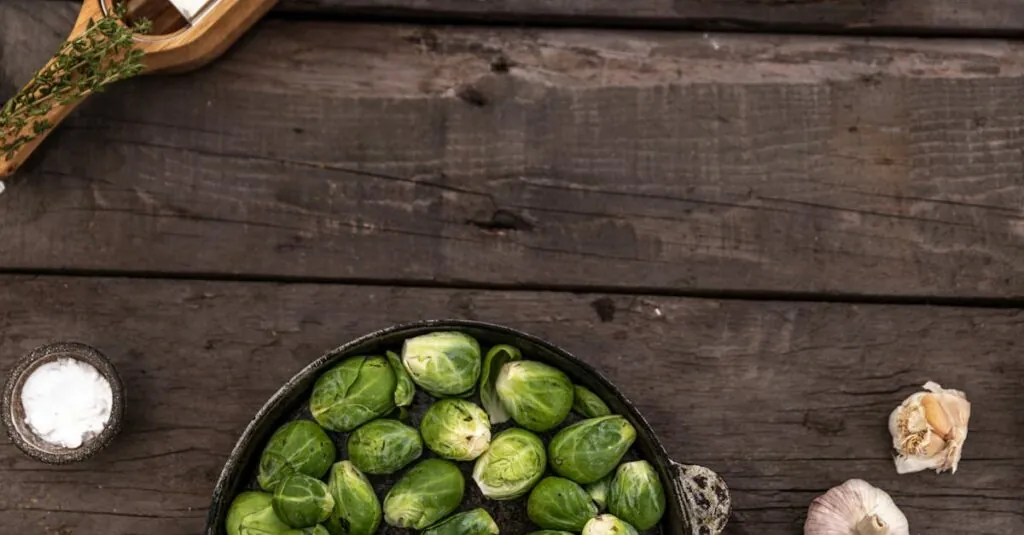Imagine walking into your kitchen, and the first thing that greets you is the gleaming surface of a perfectly seasoned cast iron skillet. It’s not just a cooking tool; it’s a culinary superhero, ready to elevate every meal from mundane to magnificent. Seasoning cast iron isn’t just about preventing rust; it’s about creating a non-stick surface that’s practically begging for your favorite recipes.
Table of Contents
ToggleUnderstanding Cast Iron
Cast iron cookware serves as a staple in many kitchens due to its durability and excellent heat retention properties. These skillets and pans are crafted from iron and are known for their ability to distribute heat evenly across the cooking surface. Their unique qualities promote superior browning and crisping of foods.
One critical aspect of cast iron is its natural non-stick surface, which develops through proper seasoning. Seasoning refers to the application of oil that bonds to the metal, creating a protective layer. Regular seasoning not only prevents rust but also improves the performance of the cookware over time.
Different types of cast iron exist, including bare cast iron, enamel-coated cast iron, and seasoned cast iron. Bare cast iron requires more maintenance but offers superior cooking abilities. Enamel-coated options provide a colorful, easy-to-clean surface, while seasoned cast iron retains cooking versatility and enhanced flavor development.
For those new to cast iron, understanding its care is essential. Cleaning involves avoiding harsh detergents and using minimal water. After cooking, a simple wipe with a cloth or a gentle scrub with a brush keeps the surface intact.
Utilizing cast iron effectively requires awareness of preheating and heat control. Gradual heating allows the metal to expand evenly and minimizes warping. A well-tempered skillet can last for generations, making it a worthwhile investment for culinary enthusiasts.
Cooks should consider the weight of cast iron; it’s heavier than other materials, contributing to its ability to absorb and retain heat. Choosing the right size for various recipes can make a significant difference while cooking.
By understanding both the characteristics and care of cast iron, cooks can maximize the benefits of this versatile culinary tool.
Benefits Of Seasoning Cast Iron
Seasoning cast iron provides numerous advantages that enhance the cooking experience. He or she who seasons cast iron benefits from improved performance and longevity.
Enhancing Durability
Improved durability results from a well-seasoned cast iron pan. Applying oil creates a protective barrier, reducing the likelihood of rust and corrosion. Enhanced protection helps preserve the surface against acidic ingredients, which can damage unseasoned cast iron. Skillets often last for generations if properly maintained. Seasoning also strengthens the integrity of the metal, making it less prone to chipping or cracking. Regular seasoning replenishes the protective layer, extending the life of the cookware.
Improving Non-Stick Properties
Non-stick properties of cast iron intensify with proper seasoning. A seasoned surface prevents food from sticking, making cooking and cleaning easier. Increased heat distribution contributes to even cooking, further reducing the chances of sticking. Cooks appreciate how seasoning allows for the preparation of delicate foods, such as eggs or fish, without the frustration of them adhering to the surface. The more frequently cast iron is used and seasoned, the better its non-stick capabilities become. Ultimately, this results in a more enjoyable and efficient cooking experience.
The Seasoning Process
Seasoning cast iron involves a series of precise steps to create a durable, non-stick surface. Proper preparation sets the foundation for effective seasoning.
Preparing The Cast Iron
First, clean the cast iron skillet thoroughly using warm water and a gentle brush. Removing any food particles or residue is crucial for optimal seasoning. If the pan has rust, use fine steel wool for a more intense scrub. After cleaning, dry the skillet completely with a towel or by placing it on low heat. Ensuring there’s no moisture helps prevent rust and promotes better oil adherence.
Applying Oil
Choose a suitable oil with a high smoke point, such as flaxseed, canola, or grapeseed oil. Apply a thin layer of oil in a circular motion using a cloth or paper towel. It’s important to coat both the interior and exterior surfaces evenly. Excess oil can lead to a sticky texture, so wiping off the excess ensures a smooth finish. This oil layer acts as a protective barrier against moisture and enhances non-stick capabilities.
Baking The Pan
Preheat the oven to 450°F (232°C) to prepare for baking the seasoned skillet. Place the skillet upside down on the oven’s middle rack to allow any excess oil to drip away. Utilizing a baking sheet on the lower rack catches drips, keeping the oven clean. Bake the pan for about an hour, letting the oil polymerize and create a hard, protective layer. After the hour, turn off the oven and allow the skillet to cool inside. This gradual cooling helps the seasoning set more effectively.
Maintaining Your Seasoned Cast Iron
Maintaining seasoned cast iron ensures long-lasting performance and usability. Following proper care techniques enhances the skillset of any cook.
Cleaning Tips
First, avoid using harsh chemicals, as these damage the seasoning layer. Gently scrub the skillet with hot water and a stiff brush to remove food residue. Utilize minimal soap when absolutely necessary, but try to use just water to keep the seasoning intact. After cleaning, be sure to dry the skillet thoroughly. Place it on low heat for a few minutes to evaporate any moisture remaining in the pan. Apply a thin layer of oil afterward to maintain the non-stick surface and prevent rust.
Re-seasoning When Necessary
Re-seasoning may become essential over time, especially if the skillet appears dull or food starts sticking. Inspect the skillet periodically for signs of wear. If the surface seems compromised, start by cleaning it thoroughly to remove any debris. Next, apply a suitable oil in a thin coat, focusing on areas needing the most attention. Bake the skillet upside down in a preheated oven for an hour, allowing excess oil to drip off. This re-seasoning process restores the non-stick properties and protects against rust, ensuring the skillet remains a reliable kitchen companion.
Mastering the art of seasoning cast iron is crucial for anyone looking to elevate their cooking experience. With proper care and attention, a well-seasoned skillet can become a cherished kitchen staple that lasts for generations. The benefits of a non-stick surface and enhanced durability are undeniable, making it a worthwhile investment for both novice and experienced cooks.
By following the outlined steps for seasoning and maintenance, it’s possible to enjoy the full potential of cast iron cookware. Embracing this timeless tool not only improves culinary results but also fosters a deeper appreciation for the craft of cooking.





